It’s very easy to talk about all the benefits of event marketing and what it can do for your business. Building your brand, engaging with your audience, generating quality leads, we could go on and on but let’s not get ahead of ourselves. Because there’s still one big obstacle that you’ve got to overcome before you can reap these rewards.
That obstacle is planning your first B2B event. For anyone involved, it’s a daunting task and presents a unique set of challenges. That’s why extensive planning and preparation are required to ensure that you always meet your goals and maximize results. The more time and effort you put into the planning stages, the more successful your event will be.
Now, before we move onto the 5 tips for planning your first B2B event. There are a couple of points worth mentioning. This is your first event, so it’s going to be a learning curve. Events require a lot of time and effort and you can’t expect it to be an instant success without putting in the planning.
Secondly, you’re not going to have any historical data meaning that you’ll be missing some key metrics. There’s nothing you can do about this but what’s important is that you have the correct framework in place to start recording all of this data. This will come in great use further down the line when you can start customizing your events. Now we’ve got that out of the way let’s take a look at the 5 steps.
Create marketing objectives that align with your business goals
You’ve made the decision to host an event – but why? To answer this, it’s important to take a step back. Events are some of the many tools that marketers have at their disposal. They’re planned for a variety of different reasons. From generating more revenue, engaging with customers, to increasing brand awareness. Evidently, these are all marketing objectives but are they aligned to your business goals?
For marketers, it’s very easy to get distracted on the smaller details without having business goals in mind. When this happens marketing objectives and business goals start to run off on a tangent. And if you don’t address this now, you’re only going to create more problems further down the line when your marketing objectives aren’t contributing to your business’ goals.
To stop this from happening. First, identify what it is that you want to achieve and how to quantify your results, then make sure that your objective is aligned with your marketing objectives. Once you’ve figured all that out, you can start creating an action that will help define the direction you choose.
Achieve one goal and stick to it

The reality is that you never have just one business goal to manage, you’re going to have to juggle multiple. That is everywhere except for when you plan an event. Here, it’s important to focus on one goal and to really go for it.
Trying to accommodate all of your business goals is going to dilute the overall message of your event. Never bite off more than you can chew because it’s going to have a big impact on your attendees and their overall experience.
Your event needs to deliver one, single message that you want to communicate with your attendees. For example, say if you’re planning on attracting leads to learn more about your brand, then you’re not going to want to invite your customers who are at a different stage in the marketing funnel.
Above all, your event needs to be refined and to do this you need to identify the actions required to achieve your goal. By doing this, you can create an event that really caters to and connects with your attendees, instead of creating one which appeals to the masses.
Focus on an attendee persona
It sounds obvious, but your event needs to be built around your attendees. Not only does it increase the chance of appealing to them but it will also help to create personal connections. Your goal is to appeal to a specific attendee in the marketing funnel and for this, you need to create an attendee persona.
This is a representation of your ideal event guest based on market research and real data that you’ve collected. Not too far off a buyer persona, this will include their backgrounds, demographics, pain points, and any other characteristics. It will also include some event-related information such as content, topic interests, and any major pain points.
The more you know about your attendees, the more value you can create on an event designed exactly to their requirements. So it’s essential that you’re able to collect as much information as possible. A good starting point for this is to conduct surveys and interviews prior to your first event.
Smooth logistics
A well-organized event is dependent on smooth logistics. So if you want to make sure that your first event isn’t going to be your last then you need to get the event logistics right. Prior to the event, there’s a number of different elements that you need to tick off.
First of all, you’ll want to map out the event venue and factor in any possibilities such as where attendees will enter and exit, along with any areas that are going to be congested with a lot of foot traffic. Have backup plans and prepare yourself for any eventuality that could occur. For every possible scenario, you’ll need to have a contingency plan.
Finally, you need to provide your attendees with a smooth check-in experience. There’s nothing worse than long queues before your attendees have entered the venue. An easy check-in streamlines the registration process, easing the workload on your staff and allowing your attendees to get straight into the event.
How to digitize
The good news is that you don’t have to run your event manually. There are simply too many factors that need to be considered when planning an event. Here, technology is your friend and there are plenty of options out there to help solve the planning points and streamline registration, check-in, and all of your data to help operations run smoothly.
Every event is different and the technology that you use will depend on your requirements along with what you want to achieve from the event. To make the right decision, identify all of the features that you want to be covered and create a checklist to see which software is the best match.
Schedule some demo calls and have a feel for the product. Make sure that the product is easy to use and that there will be no on-boarding issues. It’s also very important to check if the software has integrations with the rest of your marketing stack.
Once you have gathered and studied all of this, you can then choose the right event management technology that will be fully aligned with your requirements and your company processes.
Note: If you want to automatize and streamline the entire event planning process, you’ll want to find an all-inclusive platform that lets you run multiple types of activities.
Roundup
- When it comes to planning your first event, extensive planning and preparation are required to ensure that you always meet your goals and maximize results. The more time and effort you put into the planning stages now, the more successful your event will be.
- Remember that you’re not going to have any historical data to base the event off and that this is going to be a huge learning curve. Mistakes and errors are going to happen, just try to limit them from happening.
- Before you plan the event, make sure that your marketing objectives are aligned with your business goals. Identify what it is that you want to achieve and how to quantify your results, then make sure that your objective is aligned with your marketing objectives.
- Stick with one goal and make sure that you achieve it. Your event needs to deliver one, single message that you want to communicate with your attendees. If you’re unable to do this then the overall message of your event will become diluted.
- Who’s attending your event? To understand this create personas that will scope out who your attendees are, what pain point they’re facing, and most importantly why they’re deciding to attend your event.
- A well-organized event is dependent on smooth logistics. Make the registration and check-in process as easy as possible. Have backup plans and prepare yourself for any eventuality that could occur. For every possible scenario, you’ll need to have a contingency plan.
- Above all, make sure that you use event technology to streamline all of the processes and provide your attendees with a better experience. To identify the right technology for your event create a checklist of all the features that your organization and event require.






